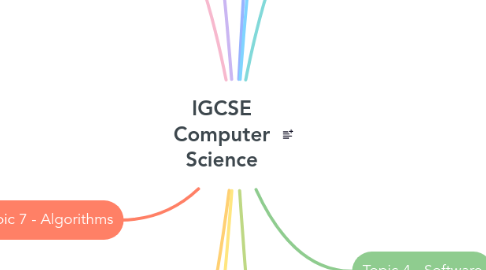
1. Topic 9 - Databases
1.1. Flat file vs relational
1.1.1. Field, Record, Primary Key, Validation
1.2. Data Types
1.2.1. Text, Character, Boolean, Integer, Real, Date/Time
1.3. SQL
1.3.1. SELECT, FROM, WHERE, ORDER BY, SUM, COUNT
2. Programming
2.1. Programming concepts
2.1.1. Sequence, selection, iteration, data types, string handling
2.2. Operators
2.2.1. arithmatic, logical and boolean
2.2.1.1. ^ (raised to power of), MOD, DIV, AND, OR, NOT
2.3. Procedures and functions
2.3.1. Define their use
2.4. Maintable programs
2.4.1. Comments, procedures and functions, meaningful syntax, variables
2.5. Arrays
2.5.1. 1D and 2D, nested iteration
2.6. File Handling
2.6.1. Open, close and use a file for reading and writing
3. Topic 7 - Algorithms
3.1. PDLC
3.1.1. Analysis, Design, Coding, testing - explain each area
3.1.1.1. Structure charts, flowcharts, pseudocode, decompostion, abstraction, purpose of an algorithm
3.2. Standard methods of solution
3.2.1. Linear search, bubble sort, totalling, counting, max, min, sum
3.3. Validation and testing
3.3.1. Range, length, type, presence, format, check, visual check, double entry, normal, abnormal, extreme boundary, trace tables
4. Topic 6 - Automated and Emerging technologies
4.1. Sensors, microprocessors and actuators can be used to make automated systems
4.1.1. Adv and Disadv rom the following scenarios: industry, transport agricutlre, weather, gaming , lighting, science
4.2. Robotics
4.2.1. 3 Characeristics - mechanical structure, electiral components, Programmable
4.2.1.1. Adv and disadv in following areas: industry, transport, agriculture, medicien, domestic, entertainment
4.3. Artifical Intelligence
4.3.1. Defintion, Expert systems, machine learning, inference engine,
5. Topic 10 - Boolean Logic
5.1. Define and understand the function of logic gates
5.1.1. NOT, AND, OR, NAND, NOR, XOR
5.2. Be able to create problem statements, logic expressions and logic circuits
6. Topic 1 - information Representation
6.1. Number systems
6.1.1. HEX, shift, 2 complement, addition, negative and positive,
6.2. Text, sound and Images
6.2.1. ASCII, Unicode, sample rate and resolution, pixels, colour depth, file size and quality
6.3. Storage and compression
6.3.1. Measurements of storage, calculations, compression, RLE, lossy vs lossless
7. Topic 2 - Data Transmission
7.1. Types and Methods
7.1.1. Packet switching, Serial, Parallel, Simplex, Half duplex, Full duplex
7.1.1.1. Advantages, Disadvantages and Uses
7.2. Methods of Error Detection
7.2.1. Errors, Error checking methods, Party byte/block, Echo, Check sum, Check digit, ARQ
7.3. Encryption
7.3.1. Purpose of encryption, Symmetric and Asymmetric - public and private keys
8. Topic 3 - Hardware
8.1. Computer Architecture
8.1.1. CPU, Microprocessor, CPU Components, Von Neumann, FDE, performance of CPU, Embedded Systems
8.1.1.1. Registers, Cores, Cache, Instruction Set
8.2. Input and Output Devices
8.2.1. What is one and why are they required, Sensors
8.2.1.1. Acoustic, accelerometer, flow, gas, humidity, infra-red, level, light, magnetic field, moisture, ph, pressure, proximity, temp,
8.3. Data Storage
8.3.1. Primary Memory VS Secondary Storage, Virtual Memory, Cloud computing
8.3.1.1. RAM and ROM, Optical, Magnetic, SSD
8.4. Network Hardware
8.4.1. NIC, MAC, IP, Routers
8.4.1.1. Characterisitcs of IP addresses, role of router
9. Topic 4 - Software
9.1. Types of Software and Interrupts
9.1.1. Difference between system software and application software, Role of the OS, Interrupt handling
9.1.1.1. Managing files, Handling interrupts, providing an interface, managaing peripherals and drivers, managing memory, managing multitasking, providing a platform for running applications, providing system security, managing user accounts
9.2. Types of Programming Language
9.2.1. High level vs Low level
9.2.1.1. Advantages and disadvantages of both
9.3. Translators
9.3.1. Compiler, Interpreter, Assembler
9.3.1.1. Characteristics and adv/disadv
9.4. IDES
9.4.1. Code editors, run time environment, translators, error diagnostics, auto-completion, auto-correction, prettyprint
10. Topic 5 - The Internet and its uses
10.1. WWW vs Internet, URL, HTTPS, Browser
10.1.1. Storing bookmarks, recording user history, allowing use of multiple tabs, storing cookies, providing navigation tools, addresss bar
10.2. Describe how web pages are located, retrieved and displayed on a device when a user enters a URL
10.2.1. Diagrams DNS, HTML, Web server
10.3. Cookies - What are they and what are their function
10.3.1. Saving personal details, tracking user preferences, Holding items in an online shopping cart
10.4. Digital Currency
10.4.1. A digital currency only exists electronically, Blockchain in its basic form is a digital ledger.
10.4.1.1. Diagrams to explain
10.5. Cyber Security
10.5.1. Processes involved and how they can be prevented
10.5.1.1. Diagrams to explain: BFA, Data interception, DDOS, hacking, Malware, Pharming, Phishing, Social Engineering
10.5.1.2. Diagrams to explain: Access level, anti malware, authenitcation, biometrics, automatic updates, spell checking, firewalls, provacy sttings, proxy servers, SSL
